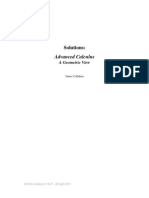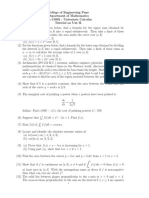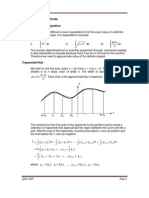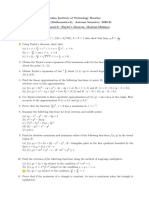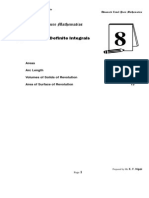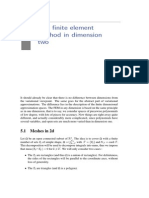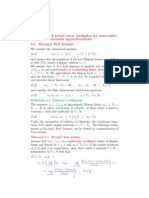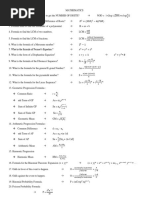MATH 2300 - Review Problems For Exam 2: Corrected Answers
Uploaded by
ammar_harbCopyright:
Available Formats
MATH 2300 - Review Problems For Exam 2: Corrected Answers
Uploaded by
ammar_harbOriginal Title
Copyright
Available Formats
Share this document
Did you find this document useful?
Is this content inappropriate?
Copyright:
Available Formats
MATH 2300 - Review Problems For Exam 2: Corrected Answers
Uploaded by
ammar_harbCopyright:
Available Formats
MATH 2300 review problems for Exam 2 CORRECTED ANSWERS
1. A pyramid of constant density gm/cm
3
has a square base of sidelength 40 cm, and a height of 10
cm.
(a) Find the mass of the pyramid.
Mass=volume density =
_
10
0
(4z)
2
dz =
16z
3
3
10
0
=
16000
3
gm.
(b) Find the center of mass of the pyramid.
Put the apex of the pyramid at the origin, with the base of the pyramid perpendicular to the
z axis. Then by symmetry, the center of mass has x-coordinate x = 0 and y-coordinate y = 0.
Furthermore,
z =
_
10
0
z(4z)
2
dz
16000
3
=
3
16000
16z
4
4
10
0
=
30
4
=
15
2
cm.
2. (corrected) A metal plate of constant density 5 gm/cm
2
has a shape bounded by the curve y =
x,
the x-axis, and the line x = 1.
(a) Find the mass of the plate.
Mass=area density = 5
_
1
0
xdx =
10
3
gm.
(b) Find the center of mass of the plate.
x =
5
_
1
0
x
xdx
10
3
=
3
5
cm, y =
5
_
1
0
y(1 y
2
) dy
10
3
=
3
8
cm.
3. Find the mass of the plate in the previous problem if, instead of constant density, the plate has
density:
(a) (x) = 1 + x,
Mass =
_
1
0
(1 + x)
xdx =
16
15
gm.
(b) (y) = 1 + y.
Mass =
_
1
0
(1 + y)(1 y
2
) dy =
11
12
gm.
4. Find the area of the region bounded by the curve r =
, for 0 .
_
0
[(
)
2
/2] d =
2
/4.
5. Find the area of the region that lies within the limacon r = 3+2 cos() and outside the circle r = 4.
1
2
_
/3
/3
[(3 + 2 cos )
2
4
2
] d =
13
3
2
5
3
.
6. Find the area of the region common to the circles r = cos() and r =
3 sin().
(Hint: tan
1
(
1
3
) =
6
.)
1
2
_
/6
0
(
3 sin )
2
d +
1
2
_
/2
/6
(cos )
2
d =
1
24
_
5 6
3
_
0.221486.
7. Find the exact length of the polar curve r = e
, for 0 /2.
_
/2
0
_
x
()
2
+ y
()
2
d =
2
_
/2
0
e
d =
2(e
/2
1).
8. (corrected) Let {f
n
} be the sequence dened recursively by f
1
= 5 and f
n
= f
n1
+ 2n + 4.
(a) Check that the sequence g
n
whose n-th term is g
n
= n
2
+5n1 satises this recurrence relation,
and that g
1
= 5. (This tells us g
n
= f
n
for all n.) We check:
g
n1
+ 2n + 4 = ((n 1)
2
+ 5(n 1) 1) + 2n + 4 = n
2
+ 5n 1 = g
n
and plainly g
1
= 5.
(b) Use the result of part (a) to nd f
20
quickly, with the aid of a calculator. f
20
= 20
2
+5 201 =
499.
9. Decide whether each of the following sequences converges. If a series converges, what does it converge
to? If not, why not?
(a) The sequence whose n-th term is a
n
= 1
1
n
. Converges to 1. (The
1
n
part goes to zero.)
(b) The sequence whose n-th term is b
n
=
n + 1
n. Converges to 0:
n + 1
n =
n + 1
n
_
n + 1 +
n + 1 +
n
_
=
n + 1 n
n + 1 +
n
=
1
n + 1 +
n
,
and the denominator of this expression grows as n gets large, so it approaches zero.
(c) The sequence whose n-th term is c
n
= cos(n). Diverges. The sequence is {1, 1, 1, 1, 1, }
which oscillates.
(d) The sequence {d
n
}, where d
1
= 2 and
d
n
= 2d
n1
for n > 1.
Diverges. The sequence is {2, 4, 8, 16, } and the terms go to innity.
10. Consider the region dened in polar coordinates by 0 /2 and 0 r
1
sin() + cos()
.
(a) Sketch a graph of this region.
(b) Use your graph to nd the area. (The integral in polar coordinates is hard!) The area is
1
2
base height = 1/2.
11. Find the arc length of the part of the cardioid r = 1 + cos() where 0 /2.
_
/2
0
_
2(1 + cos()) d = 2
2.
12. The following integrals represent the area of some region in the xy plane. Draw a graph of the area,
labeling the axes and giving the equation(s) of the function(s).
(a)
_
0
2
(4x) dx The triangle bounded by y = 4x, x = 2, and the x-axis.
(b)
_
3
3
(
_
9 x
2
) dx The semicircle bounded by y =
9 x
2
and the x-axis.
(c)
_
2
1
3y dy The region bounded by y = x/3, x = 3, x = 6, and the x-axis.
(d)
_
1
0
(
y y) dy The region bounded by y = x
2
and y = x.
13. Using slices parallel to the base, write a denite integral representing the volume of a cone with a
height of 10 cm and a base of diameter 6 cm.
_
10
0
_
3
10
x
_
2
dx or
_
10
0
_
3
3
10
x
_
2
dx
14. Find the sum of the series. For what values of the variable does the series converge to this sum?
(a) 1 +
x
2
+
x
2
4
+
x
3
8
+ =
2
2 x
, for |x| < 2
(b) y y
2
+ y
3
y
4
+ =
y
y + 1
, for |y| < 1
(c) 4 + z +
z
2
3
+
z
3
9
+ =
z 12
z 3
, for |z| < 3
15. (corrected) A ball is dropped from a height of 10 feet and bounces. Assume that there is no air
resistance. Each bounce is
3
4
of the height of the bounce before.
(1) Find an expression for the height to which the ball rises after it hits the oor for the nth time.
H(n) = 10(
3
4
)
n
(2) Find an expression for the total vertical distance the ball has traveled when it hits the oor for
the nth time. D(n) = 10 + (2 10 (3/4))
(1 (3/4)
n1
1 (3/4)
.
(3) Using without proof the fact that a ball dropped from a height of h feet reaches the ground in
h/4 seconds: Will the ball bounce forever? If not, how long it will take for the ball to come to rest?
The ball will not bounce forever. The total time it bounces is given by
(
10/4) + a/(1 r), with a = (1/2)
_
10 (3/4) and r =
_
3/4.
16. In theory, drugs that decay exponentially always leave a residue in the body. However in practice,
once the drug has been in the body for 5 half-lives, it is regarded as being eliminated. If a patient
takes a tablet of the same drug every 5 half-lives forever, what is the upper limit to the amount of
drug that can be in the body?
Let P
n
represent the percentage of the drug in the body after the nth tablet. Then
P
1
= 1 (100 percent)
P
2
= 1(.5 .5 .5 .5 .5) + 1 = 1.03125
P
3
= 1.03125(.03125) + 1 = 1.03223
So,
P
n
=
1 (.03125)
n
1 .03125
.
As n , P
n
1.0323, so this is the maximum amount of the drug in the body.
17. Derive the volume formulas for the following shapes by using an appropriate integral:
(a) a circular cylinder of height H whose radius is R,
_
H
0
R
2
dh
(b) a circular cone of height H whose radius at the base is R,
_
H
0
_
R
h
H
_
2 dh
(c) a square pyramid of height H whose base has side length S,
_
H
0
_
S
h
H
_
2
dh
(d) a triangular pyramid of height H whose base is an equilateral triangle with side length S,
_
H
0
3
4
_
S
h
H
_
2
dh
(e) a sphere of radius R.
_
R
R
(R
2
h
2
) dh
18. Suppose that 0 f(x) g(x) for x a. If
_
a
f(x)dx converges and
_
a
g(x)dx diverges, then
is the area between the curves f(x) and g(x) for x a nite or innite? Innite: this area is
_
a
g(x)dx
_
a
f(x)dx, which is an innite number minus a nite one.
19. Determine whether the following integrals converge or diverge:
(a)
_
1
5 2 sin(e
x
)
x
2
dx converges
(b)
_
1
1
x + ln x
dx diverges
(c)
_
1
x
2
+ x + 1
x
5
+ 3x
2
+ 1
dx converges
(d)
_
1
1
e
x
x
dx converges
(e)
_
0
e
x
e
2x
+ 1
dx converges
20. Consider the region bounded by y =
x, y = 0, x = 1.
(a) Sketch the solid obtained by rotating the above region around the x-axis.
(b) Using the sketch, write a Riemann sum approximating the volume of the solid.
x)
2
x =
xx
(c) Convert your sum into an integral and nd the volume.
_
1
0
xdx =
2
(d) Repeat parts (a)-(c) with the same region rotated around the y-axis.
(y
2
)
2
y =
y
4
y
_
1
0
y
4
dy =
5
21. Using the table below, estimate the length of the curve given by y = f(x) from (3, 4) to (6, 0.7).
x 3 3.5 4 4.5 5 5.5 6
f(x) 4 3.6 2.4 -1 -0.5 0 0.7
f
(x) -0.8 -2.4 -6.8 1 1 1.4 -0.4
The appropriate arc length formula is
L =
_
b
a
_
1 + (f
(x))
2
dx
So, we can nd a good estimate of the total length by using the table
L
_
1 + (0.8)
2
(.5) +
_
1 + (2.4)
2
(.5) +
_
1 + (6.8)
2
(.5)
+
_
1 + (1)
2
(.5) +
_
1 + (1)
2
(.5) +
_
1 + (1.4)
2
(.5)
22. Find the volume of the solid whose base is the region in the xy-plane bounded by the curves y = x
and y = x
2
and whose cross sections perpendicular to the x-axis are squares with one side in the
xy-plane.
Since the cross sections are perpendicular to the x-axis we will have slices of thickness x. The
volume of each slice will be given by yx where y = x x
2
. The Riemann sum approximating the
volume is then
(x x
2
)
2
x
This leads us to computing the volume of the solid by the integral
_
1
0
(x x
2
)
2
dx
23. Do the same thing as the previous problem except with semi-circle cross sections and then again with
cross sections that are isosceles triangles of height 3.
For semi-circle cross sections we use the same method as above to get
_
1
0
1
2
_
x x
2
2
_
2
dx
as the volume of the solid. For the isosceles triangle cross-sections we get a volume of
_
1
0
1
2
(x x
2
)(3) dx
24. A steady wind blows a kite due east. The kites height above ground from horizontal position x = 0
to x = 80 feet is given by
y = 150
1
40
(x 50)
2
Find the distance traveled by the kite.
This distance traveled can be calculated by nding the arc length of the above curve from x = 0 to
x = 80. Using the arc length formula we nd the distance traveled to be
L =
_
80
0
_
1 + (
1
20
(x 50))
2
dx
25. Supplemental Problems from Section 8.2: 17, 21
26. A certain bacteria is growing in a petri dish of volume 300 cm
3
. Assume that each bacterium occupies
1 10
12
cm
3
, and that the growth rate of the bacteria, starting at time t = 1 hour, is given by
r(t) =
sin(t) + 2
t
bacteria
hour
.
Will the bacteria ever outgrow the petri dish? Explain your answer carefully.
Yes, the bacteria will outgrow the petri dish. We will show that total quantity of bacteria tends to
as t goes to , so the total volume of the bacteria will eventually exceed the volume of the petri
dish, regardless of the size of the bacteria.
Note that the total quantity of bacteria after b hours is equal to (the amount of bacteria after 1 hour)+
_
b
1
r(t) dt. Thus, we are trying to show that
lim
b
_
b
1
sin(t) + 2
t
dt = ,
i.e. we want to show
_
1
sin(t)+2
t
dt = . We use a comparison. Notice that 1 sin(t) + 2, so
1
t
sin(t)+2
t
. Thus,
_
1
1
t
dt
_
1
sin(t)+2
t
dt. We know that
_
1
1
t
dt diverges to , so
_
1
sin(t)+2
t
dt
must diverge to innity as well.
27. Show that the volume contained in the solid obtained by rotating the curve y = e
x
, from x = 1 to
, about the x-axis is nite. To calculate the volume of the solid, we slice the solid perpendicular
to the x-axis to get slices that look approximately like cylinders of height (or width, depending on
your point of view) x. Now, we make the following calculations.
The volume of a slice r
2
h = e
2x
x
The volume of the solid
e
2x
x
The volume of the solid = lim
x0
e
2x
x =
_
1
e
2x
dx
Thus, we need to show that
_
1
e
2x
dx is nite. We use a comparison. Using the facts that
f(y) = e
y
is an increasing function of y and that 2x is less than x for x 1, we see that
0 e
2x
e
x
for x 1. We conclude that 0
_
1
e
2x
dx
_
1
e
x
dx. Since
_
1
e
x
dx
is nite (this improper integral can be calculated directly),
_
1
e
2x
dx must also be nite.
28. (corrected) The density of oil in a circular oil slick on the surface of the ocean at a distance r meters
from the center of the slick is given by (r) = 50/(1 + r) kg/m
2
.
(a) If the slick extends from r = 0 to r = 10, 000 m, nd a Riemann sum approximating the total
mass of the oil in the slick.
2r
i
50
1 + r
i
r
(b) Find the exact value of the mass of oil in the slick by turning your sum into an integral, and
evaluating it.
2
_
10000
0
50r
1 + r
dr 3.1387 10
6
.
(c) Within what distance r is half of the oil slick contained? about 5004 meters
29. Determine if the following statements are true or false. If the statement is true, clearly explain why.
If the statement is false, give an example exhibiting why it is false.
(a) If f is continuous on [0, ) and lim
x
f(x) = 0, then
_
0
f(x) dx converges. FALSE. f(x) as
given below is a counterexample.
f(x) =
_
1, x 1
1
x
, x > 1
(b) If f is continuous on [0, ) and
_
0
f(x) dx diverges, then lim
x
f(x) = 0. FALSE. This statement
is logically equivalent to the previous one, so the above f(x) is again a counterexample.
(c) If f
is continuous on [0, ) and lim
x
f(x) = 0, then
_
0
f
(x) dx = f(0).
TRUE. Observe that
_
0
f
(x) dx = lim
b
_
b
0
f
(x) dx
= lim
b
[f(b) f(0)]
= f(0).
(d) If
_
0
f(x) dx and
_
0
g(x) dx both converge, then
_
0
(f(x)+g(x)) dx converges. TRUE. Assume
that
_
0
f(x) dx and
_
0
g(x) dx both converge. Then there is a number L
1
such that
_
b
0
f(x) dx
is as close as we want to L
1
for large enough b (that is, for all b larger than some N
1
). Similarly,
there is a number L
2
such that
_
b
0
g(x) dx is as close as we want to L
2
for large enough b (that
is, for all b larger than some N
2
). This implies that
_
b
0
f(x) dx+
_
b
0
g(x) dx =
_
b
0
(f(x) +g(x)) dx
can be made as close as we want to L
1
+ L
2
for large enough b. Thus,
_
0
(f(x) + g(x)) dx
converges (to L
1
+ L
2
).
(e) If
_
0
f(x) dx and
_
0
g(x) dx both diverge, then
_
0
(f(x) +g(x)) dx diverges. FALSE.
_
0
1
x
dx
and
_
0
1
x
dx both diverge, but
_
0
1
x
+
1
x
dx =
_
0
0 dx certainly converges.
30. Find the values of a for which the series converges/diverges:
(a)
n=1
_
1
2a
_
n
|a| > 1/2
(b)
n=1
1
a
_
1
2
_
n
a = 0
(c)
n=1
_
2
n
_
a
a > 1
(d)
n=1
(ln a)
n
e
1
< a < e
(e)
n=2
1
n(ln n)
a
a > 1
(f)
n=1
(1 + a
n
) diverges for all a
(g)
n=1
(1 + a)
n
2 < a < 0
(h)
n=1
n
ln a
0 < a < e
1
(i)
n=1
a
ln n
0 < a < e
1
You might also like
- Instructor's Solutions Manual To Advanced Calculus - A Geometric View ( James J. Callahan )100% (2)Instructor's Solutions Manual To Advanced Calculus - A Geometric View ( James J. Callahan )112 pages
- MATH39001 - Combinatorics and Graph Theory - Exam - Jan-2011No ratings yetMATH39001 - Combinatorics and Graph Theory - Exam - Jan-20118 pages
- Lecture 2 Calculus of Multi Variables 2011No ratings yetLecture 2 Calculus of Multi Variables 201122 pages
- Numerical Methods 5.1 Numerical IntegrationNo ratings yetNumerical Methods 5.1 Numerical Integration5 pages
- ISI Sample Question 2015 For B.stat & B.math100% (1)ISI Sample Question 2015 For B.stat & B.math9 pages
- Practice Quiz 2: Daniel Seleznev March 2014No ratings yetPractice Quiz 2: Daniel Seleznev March 20144 pages
- Assignment - 4: Applications of Derivatives: X 2! X 2 X 4! X 3! X 2! X 4! X 3! X 5! X 2 1 Cos X X /2 Sin C CNo ratings yetAssignment - 4: Applications of Derivatives: X 2! X 2 X 4! X 3! X 2! X 4! X 3! X 5! X 2 1 Cos X X /2 Sin C C5 pages
- MIT Multivariable Calculus Exam A SolutionsNo ratings yetMIT Multivariable Calculus Exam A Solutions16 pages
- MATH39001 - Combinatorics and Graph Theory - Exam - Jan-2010No ratings yetMATH39001 - Combinatorics and Graph Theory - Exam - Jan-201010 pages
- Maths Class Xii Chapter 06 Application of Derivatives Practice Paper 06 2024 AnswersNo ratings yetMaths Class Xii Chapter 06 Application of Derivatives Practice Paper 06 2024 Answers8 pages
- Blue Print: Class Xii Maths: Model Question PaperNo ratings yetBlue Print: Class Xii Maths: Model Question Paper14 pages
- Ref 6 - Arbitrary-Order Nodal Mimetic DiscretizationsNo ratings yetRef 6 - Arbitrary-Order Nodal Mimetic Discretizations41 pages
- Math 383H - Linear Algebra and Differential Equations (Metcalfe)No ratings yetMath 383H - Linear Algebra and Differential Equations (Metcalfe)4 pages
- Solutions 1.7-Page 79 Problem 3: X X DT DX X DXNo ratings yetSolutions 1.7-Page 79 Problem 3: X X DT DX X DX7 pages
- Solving Inequalities Worksheet: Name - DateNo ratings yetSolving Inequalities Worksheet: Name - Date2 pages
- Math 40 Lecture 6: Linear Independence Continued and Matrix OperationsNo ratings yetMath 40 Lecture 6: Linear Independence Continued and Matrix Operations3 pages
- Chapter 5 A Priori Error Estimates For Nonconfor-Ming Finite Element Approximations 5.1 Strang's First LemmaNo ratings yetChapter 5 A Priori Error Estimates For Nonconfor-Ming Finite Element Approximations 5.1 Strang's First Lemma24 pages
- Cls Jeead-17-18 Xi Mat Target-1 Set-2 Chapter-30% (1)Cls Jeead-17-18 Xi Mat Target-1 Set-2 Chapter-3166 pages
- Two Tier Gcse Maths Homework Pack 2 Higher Tier Trigonometry100% (1)Two Tier Gcse Maths Homework Pack 2 Higher Tier Trigonometry8 pages
- Inverse Trigonometric Funtcion DPP - 4-1No ratings yetInverse Trigonometric Funtcion DPP - 4-12 pages
- XI - Maths - Chapter 13 - APPLICATION OF DERIVATIVES - (W.E) - 11.03.2015 (179-187)No ratings yetXI - Maths - Chapter 13 - APPLICATION OF DERIVATIVES - (W.E) - 11.03.2015 (179-187)9 pages
- Chapter 2 Introduction To Signals StudentsNo ratings yetChapter 2 Introduction To Signals Students67 pages
- Oxfordaqa International As and A Level Further Mathematics SpecificationNo ratings yetOxfordaqa International As and A Level Further Mathematics Specification32 pages
- Math-3 - Module-7 Calculus Integration by PartsNo ratings yetMath-3 - Module-7 Calculus Integration by Parts3 pages
- Grade 10 - 12 FET Mathematical SBA ExemplarNo ratings yetGrade 10 - 12 FET Mathematical SBA Exemplar75 pages
- Additional Mathematics 2010 June Paper 11No ratings yetAdditional Mathematics 2010 June Paper 118 pages
- Class X Maths QP 30-5-3 Panchkula Region (2023-24)No ratings yetClass X Maths QP 30-5-3 Panchkula Region (2023-24)12 pages
- Calculus I - Trig Equations With Calculators, Part INo ratings yetCalculus I - Trig Equations With Calculators, Part I6 pages
- Instructor's Solutions Manual To Advanced Calculus - A Geometric View ( James J. Callahan )Instructor's Solutions Manual To Advanced Calculus - A Geometric View ( James J. Callahan )
- MATH39001 - Combinatorics and Graph Theory - Exam - Jan-2011MATH39001 - Combinatorics and Graph Theory - Exam - Jan-2011
- Assignment - 4: Applications of Derivatives: X 2! X 2 X 4! X 3! X 2! X 4! X 3! X 5! X 2 1 Cos X X /2 Sin C CAssignment - 4: Applications of Derivatives: X 2! X 2 X 4! X 3! X 2! X 4! X 3! X 5! X 2 1 Cos X X /2 Sin C C
- MATH39001 - Combinatorics and Graph Theory - Exam - Jan-2010MATH39001 - Combinatorics and Graph Theory - Exam - Jan-2010
- Maths Class Xii Chapter 06 Application of Derivatives Practice Paper 06 2024 AnswersMaths Class Xii Chapter 06 Application of Derivatives Practice Paper 06 2024 Answers
- Transformation of Axes (Geometry) Mathematics Question BankFrom EverandTransformation of Axes (Geometry) Mathematics Question Bank
- A-level Maths Revision: Cheeky Revision ShortcutsFrom EverandA-level Maths Revision: Cheeky Revision Shortcuts
- Ref 6 - Arbitrary-Order Nodal Mimetic DiscretizationsRef 6 - Arbitrary-Order Nodal Mimetic Discretizations
- Math 383H - Linear Algebra and Differential Equations (Metcalfe)Math 383H - Linear Algebra and Differential Equations (Metcalfe)
- Math 40 Lecture 6: Linear Independence Continued and Matrix OperationsMath 40 Lecture 6: Linear Independence Continued and Matrix Operations
- Chapter 5 A Priori Error Estimates For Nonconfor-Ming Finite Element Approximations 5.1 Strang's First LemmaChapter 5 A Priori Error Estimates For Nonconfor-Ming Finite Element Approximations 5.1 Strang's First Lemma
- Two Tier Gcse Maths Homework Pack 2 Higher Tier TrigonometryTwo Tier Gcse Maths Homework Pack 2 Higher Tier Trigonometry
- XI - Maths - Chapter 13 - APPLICATION OF DERIVATIVES - (W.E) - 11.03.2015 (179-187)XI - Maths - Chapter 13 - APPLICATION OF DERIVATIVES - (W.E) - 11.03.2015 (179-187)
- Oxfordaqa International As and A Level Further Mathematics SpecificationOxfordaqa International As and A Level Further Mathematics Specification
- Class X Maths QP 30-5-3 Panchkula Region (2023-24)Class X Maths QP 30-5-3 Panchkula Region (2023-24)
- Calculus I - Trig Equations With Calculators, Part ICalculus I - Trig Equations With Calculators, Part I

